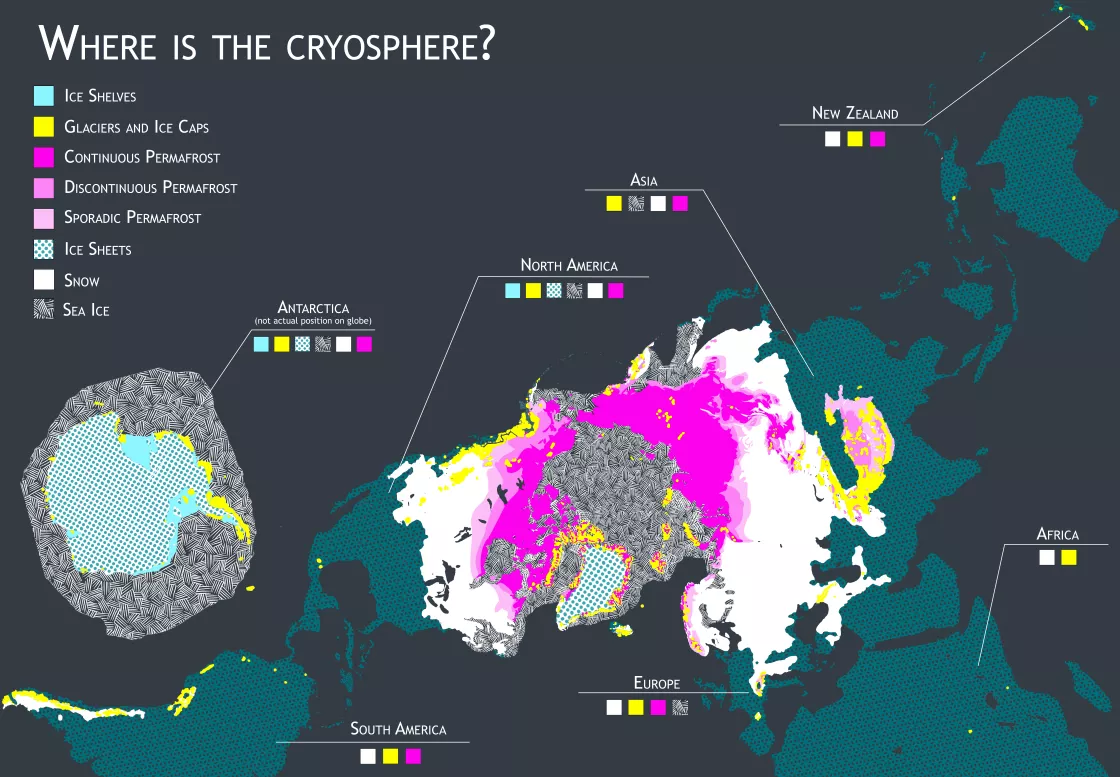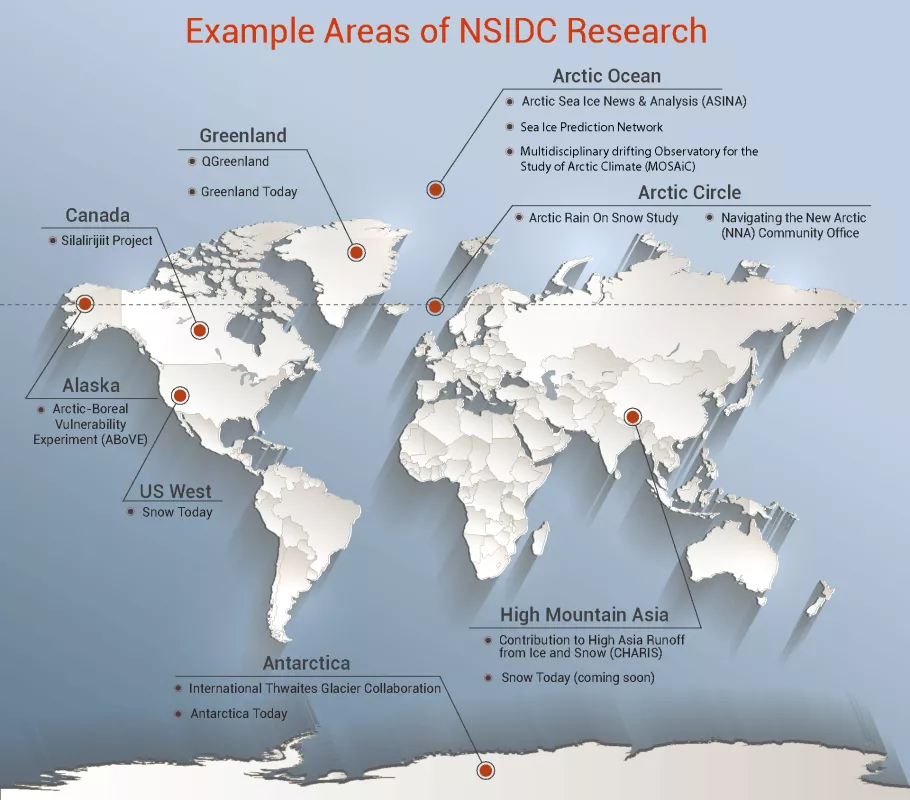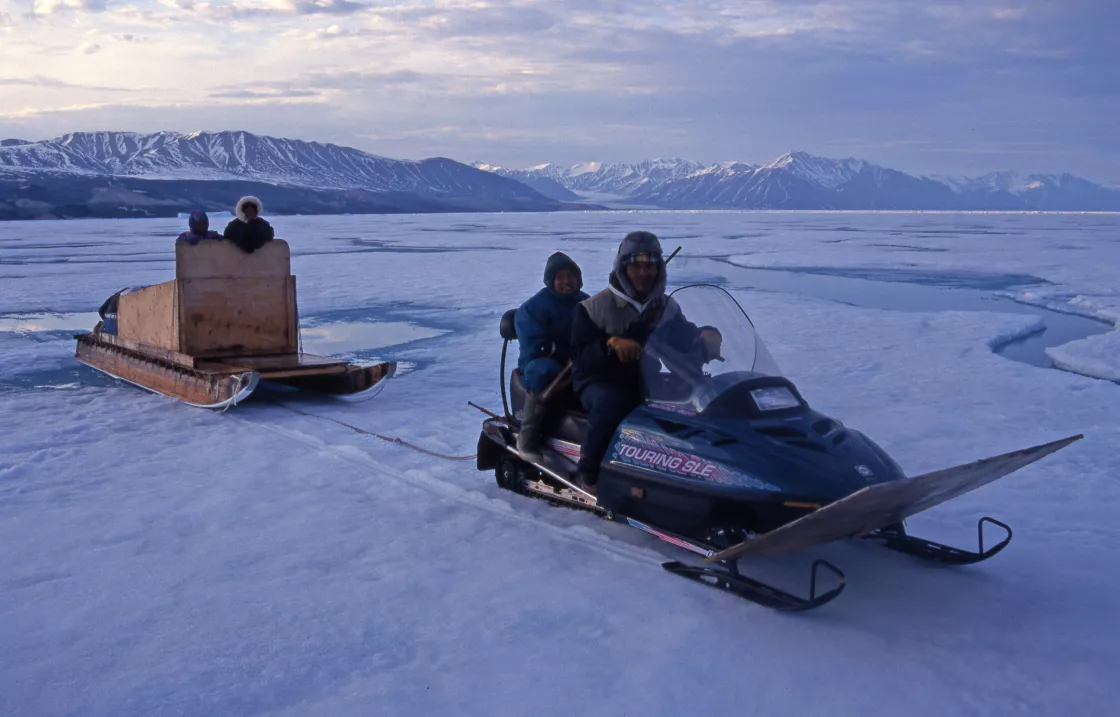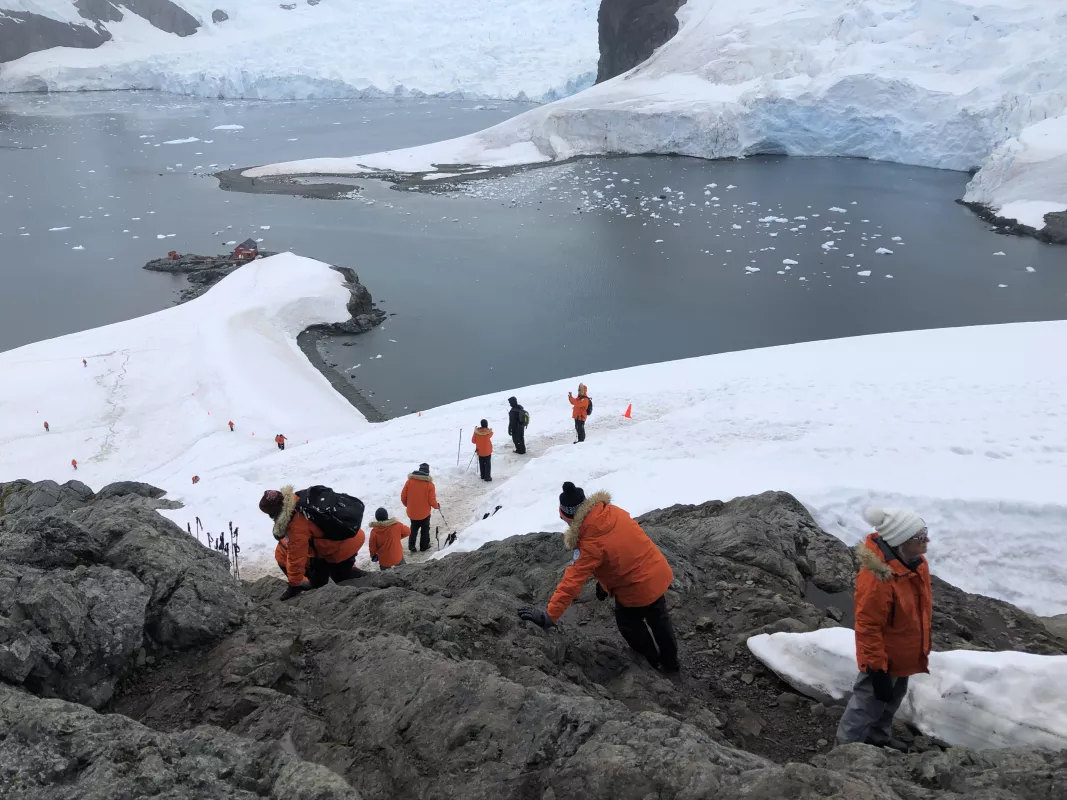Our Research
Overview
The cryosphere is a global system stretching from the Arctic to the Antarctic and includes all the snow, ice, and other frozen regions across the planet. These frozen parts of Earth are important components of the global climate system, and provide fresh water and other ecosystem services to people, plants, and animals. As climate change warms the planet, the cryosphere is one of the most rapidly changing systems on Earth. Sea ice and glaciers are disappearing, permafrost is thawing, snow in the polar regions is turning to rain, and so on. These changes affect communities, habitats, sea levels, ocean currents, air temperatures, and more. The better we understand what is happening with the cryosphere, the more we know what other changes are occurring across our planet—that is why NSIDC’s research is more urgent now than ever.
Since 1976, NSIDC scientists have worked to improve understanding of how the cryosphere is changing, forecasting of what the impacts of these changes will be, and global awareness of the importance of the cryosphere. Our organization includes physical and social scientists with centuries of experience between them. We believe rigorous scientific research is essential to the stewardship of our planet and positively impacts the future of humanity.
Areas of research
From the physical sciences to the social sciences, NSIDC scientists work on a diverse mixture of research projects that focus on various aspects of the cryosphere and how it impacts society, including snow, glaciers, ice caps, ice sheets, sea ice, permafrost, and more. These research projects take place across the cryosphere, including in the Arctic Ocean, Antarctica, Alaska, Canada, the Sierra Nevada, the Rocky Mountains, the polar oceans, Tibet, Svalbard, Greenland, High Mountain Asia, the Andes, the high desert of the Western United States, and elsewhere.
Championing open science and data
“Open science is the idea that scientific knowledge of all kinds should be openly shared as early as is practical in the discovery process.” –Michael Nielson
In order to best serve our audiences and make our scientific research as accessible as possible, NSIDC champions open science. This is the concept that scientific research should be accessible, transparent, and reproducible. Open science encourages diversity and access, makes science more global and collaborative, and accelerates discovery. It includes four pillars: open data, open code, open access to papers, and open review. To promote open science, NSIDC researchers and staff:
- Host data tutorials to help people understand how to use NSIDC data.
- Create and host tools to help the public use and understand NSIDC data, such as the Charctic Interactive Sea Ice Graph and QGreenland, a free mapping tool that supports interdisciplinary Greenland-focused research.
- Developed the OpenAltimetry platform to allow the discovery, access, and visualization of data from NASA’s ICESat and ICESat-2 missions, in coordination with UNAVCO, the Scripps Institution of Oceanography, and San Diego Supercomputer Center at the University of California San Diego. OpenAltimetry exemplifies open science by making complex data easy to access and visualize, even by non-experts.
The science team is also continually submitting scientific research papers to open access journals and making software and code available on the NSIDC website, as well as public repositories like GitHub and Bitbucket.
Open data
Making data accessible
Championing data accessibility is at the core our work at NSIDC, especially through our data management and stewardship programs, which include the NASA National Snow and Ice Data Center Distributed Active Archive Center (NSIDC DAAC), NOAA@NSIDC, and the Exchange for Local Observations and Knowledge of the Arctic (ELOKA). NSIDC is also a CoreTrustSeal certified Regular Member of the World Data System, an Interdisciplinary Body of the International Science Council. NSIDC works to follow the guiding principles for best practices when it comes to data management and access: the Findable, Accessible, Interoperable, and Reusable (FAIR) principles and the Collective benefit, Authority control, Responsibility, and Ethics (CARE) principles.
The FAIR Guiding Principles for scientific data management and stewardship focus on making data findable, accessible, interoperable, and reusable. Ultimately, the main goal of the FAIR principles is to optimize data for reuse. A major way that NSIDC practices the FAIR principles is through the NASA National Snow and Ice Data Center Distributed Active Archive Center (NSIDC DAAC), which provides tax-payer funded data on snow, sea ice, glaciers, ice sheets, ice shelves, frozen ground, soil moisture, climate interactions, and more, that anyone can use, free of charge. In addition, NSIDC ensures full, machine-accessible metadata for its holdings, and Application Programming Interfaces (APIs) for services on its data.
NSIDC also recognizes Indigenous data sovereignty and support the rights of Indigenous Peoples to maintain control of their own knowledge and data. The CARE Principles for Indigenous Data Governance focuses on the role of data in advancing Indigenous innovation and determination. These principles complement the FAIR principles and take into account Indigenous Peoples’ rights to data sovereignty: the right to govern the collection, ownership, and application of its own data. One way that NSIDC champions the CARE principles is through the Exchange for Local Observations and Knowledge of the Arctic (ELOKA) program, which facilitates the collection, preservation, exchange, and use of local observations and knowledge of the Arctic. ELOKA provides data management and user support and fosters collaboration between resident Arctic experts and visiting researchers.
Communications and outreach
NSIDC is a trusted source for information about the cryosphere, in large part because our scientists understand the value of sharing science so that it is accessible to everyone. They often go above and beyond the typical requirements of scientific research to participate in communications and outreach projects for a variety of audiences, including journalists, educators, policymakers, and the general public. For example, NSIDC scientists, in coordination with scientists from outside organizations, regularly post easy-to-read scientific analyses on how the cryosphere is changing and what is driving those changes. These analyses include the Arctic Sea Ice News & Analysis, Ice Sheets Today, and Snow Today. NSIDC also regularly hosts open-access Cryosphere Seminars, which feature NSIDC scientists and guests sharing their cryospheric research and findings. In addition, NSIDC science team members offer their expertise on the polar regions by testifying before Congress, giving public lectures, writing books about how climate change is influencing the frozen parts of the world, and visiting K-12 schools to expose students firsthand to cryospheric science and scientists. NSIDC scientists also regularly contribute to reports about the changing cryosphere, including the National Oceanic and Atmospheric Administration’s (NOAA) Arctic Report Card and the Bulletin of the American Meteorological Society’s State of the Climate Report.
Collaboration and funding
NSIDC has a long history of collaboration with various types of organizations in the public, private, and non-profit sectors. Our scientists are always searching for new ways to work with those outside of our organization, including soft money and early career scientists. For example, several NSIDC scientists are involved with large cryosphere-focused organizations, such as University of the Arctic, the Scientific Committee on Antarctic Research, the International Arctic Science Committee, the American Geophysical Union, the US Permafrost Association, the American Meteorological Society, and the American Association for the Advancement of Science. They have also taken part in the Multidisciplinary drifting Observatory for the Study of Arctic Climate (MOSAiC) expedition, which was the first year-round expedition into the central Arctic exploring the Arctic climate system, as well as the International Thwaites Glacier Collaboration, a joint US and UK project to investigate Thwaites Glacier, one of the most unstable glaciers in Antarctica. Several NSIDC scientists also sit on the leadership team of the Sea Ice Prediction Network (SIPN), a network of scientists and stakeholders working to improve and communicate sea ice prediction knowledge and tools. In addition, NSIDC participates in the CIRES Visiting Fellows Program, inviting both early career and more senior Visiting Fellows to work with NSIDC researchers for a specified timeframe on various topics.
Funding for NSIDC scientific research comes from various sources, including NASA, the National Science Foundation (NSF), NOAA, and the Department of Energy (DOE).



